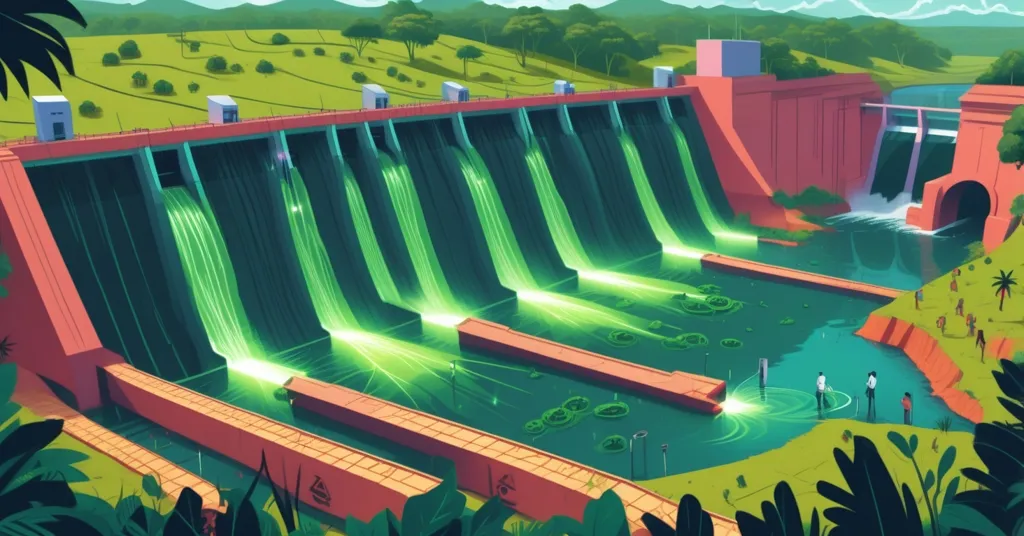Paraguay’s Bitcoin Mining Boom: Sustainable Haven or Community Nightmare?

Bitcoin Mining in Paraguay: Green Energy Goldmine or Community Curse?
Paraguay’s Bitcoin mining boom, powered by surplus hydroelectric energy from the Itaipú Dam, is being hailed as a model of sustainable crypto operations by the country’s power provider. Yet, beneath the rosy claims lie gritty realities—community unrest over noise pollution, murky financial projections, and a regulatory tightrope that could make or break this South American haven for miners. Let’s dig into the dirt, both the good and the damn ugly.
- Energy Stats: Miners use over 700 MW now, targeting 1,000 MW by 2025, fueled by renewable hydropower.
- Grid Claims: Power officials insist there’s no strain on public supply, but billing discrepancies raise red flags.
- Human Toll: Noise pollution and illegal operations are sparking backlash and crackdowns.
Paraguay’s Bitcoin Mining Energy Edge
At the core of Paraguay’s appeal to Bitcoin miners is the Itaipú Dam, a colossal hydroelectric plant on the border with Brazil. This beast is one of the largest power generators in the world, producing enough energy to light up entire countries. Paraguay, with a population of just 7 million, can’t consume all its share—roughly half the dam’s output operates at a frequency suited for its grid, leaving a massive surplus historically wasted or sold off to Brazil for peanuts. Bitcoin miners have swooped in to tap this abundance, currently drawing over 700 MW of power, with the National Electricity Administration (ANDE) projecting a rise to 1,000 MW by 2025. To put that in perspective, 700 MW could power about 500,000 average households for a year—a staggering slice of juice for a niche industry.
Félix Sosa, President of ANDE, has been quick to frame this as a non-issue for everyday Paraguayans.
“Our priority is to ensure responsible energy use, consistent with the capacity of the Paraguayan system,”
he told Criptonoticias, stressing that mining operations are placed in zones that avoid overloading critical infrastructure. From a Bitcoin maximalist lens, this is a dream scenario: cheap, green energy fueling a decentralized financial revolution while flipping the bird to critics who bash crypto’s carbon footprint. With Itaipú’s renewable output, Paraguay could be the poster child for sustainable Bitcoin mining, a counterpunch to coal-heavy operations elsewhere. ANDE even projects a cool $240 million in revenue from this expansion by 2025, painting a picture of economic upside for a developing nation.
Economic Cracks: Rate Hikes and Shaky Math
Before we start carving statues of Sosa, let’s talk numbers—and the stench of something off. Engineer Axel Benítez has thrown a wrench into ANDE’s shiny narrative, pointing out a glaring gap: while 700 MW is reportedly consumed by miners, only 255.5 MW was billed in 2024. That’s a massive chunk of unaccounted energy. Is ANDE’s data just sloppy, or are illegal setups siphoning power under the radar? Worse, Benítez took a hard look at the $240 million revenue target for 1,000 MW by 2025 and broke out the calculator.
“If they are planning to go from 700 to 1,000 MW by the end of 2025 and ANDE is set to collect $240 million, a simple math calculation results in a rate of $80 per megawatt hour. That is almost double the current rate for [crypto miners]. So, that means that either a rate hike is coming, or ANDE doesn’t know how to use a calculator,”
he fired off with a jab. To add salt to the wound, a 16% tariff hike—basically a price jump per unit of electricity—was already slapped on formal miners in June 2024, according to The Paraguay Post. If Benítez’s math holds, and rates could nearly double again, smaller mining outfits might get crushed or pushed into the shadows. For those of us rooting for decentralization and freedom from centralized overreach, this reeks of a utility squeezing a golden goose until it croaks. Sure, ANDE needs to balance its books, but at the expense of the very industry it’s courting?
This isn’t just a local squabble—it’s a preview of how economic pressures can erode crypto’s promise. If affordable power was Paraguay’s selling point, jacking up costs could send miners packing to the next cheap-energy haven. Or worse, drive them underground, where oversight is nil and risks skyrocket. How do you champion a borderless, disruptive tech when the host nation starts playing hardball with the price tag?
Community Backlash: A Soundtrack of Suffering
Beyond watts and dollars, there’s a human story here, and it’s not pretty. In Santa Lucía District, Villarrica, residents are enduring a relentless hum from mining rigs, clocking in at 75 decibels—well above the 60 dB nighttime limit set by local standards. For context, 60 dB is like a loud conversation; 75 dB is closer to a vacuum cleaner droning nonstop outside your bedroom window. María Sol Arrúa Ayala, a local lawyer and resident, called the noise “distressing,” telling The Paraguay Post it’s like “being inside a washing machine.” The fallout is brutal:
- Sleep deprivation plaguing entire families.
- Stress and panic attacks, especially in children.
- Reports of ear bleeding from the constant sound assault.
- Particular hardship for kids with special needs, who struggle most with sensory overload.
This isn’t just whining about a loud neighbor; it’s a public health crisis. Legal actions are underway, including a criminal investigation into noise pollution in the area. For an industry we tout as the future of finance, this is a gut punch—Bitcoin mining turning quiet towns into sound torture zones. Can the promise of decentralization justify making life hell for those caught in the crossfire? It’s a question the crypto world can’t dodge if we want mainstream adoption without blood on our hands.
Illegal Mining: A Shadow Over Progress
Then there’s the underbelly of this boom—illegal mining operations bleeding Paraguay dry. ANDE estimates it loses a full third of its energy production, with unauthorized rigs playing a big role. Over 10,000 mining units have been seized in recent crackdowns, and new penalties now threaten energy thieves with up to 10 years behind bars. It’s a stark reminder that cheap power draws not just innovators but opportunists. For our readers, this hits at a core tension in crypto: how do you integrate a tech built on defying centralized control into a national grid that demands oversight? Paraguay’s cheap juice is a magnet for disruption, but also for chaos. Illegal ops don’t just hurt ANDE’s bottom line—they risk tainting the whole industry as a lawless free-for-all, as noted in community discussions.
Regulatory Roulette: Haven or Hell?
Policy in Paraguay is a battlefield with no clear winner in sight. Last year, 14 senators pushed for a temporary ban on crypto mining over power concerns—a move that fizzled but left a bad taste. Fast forward to 2024, and the landscape is messier still, with a flood of congressional bills ranging from practical regulation to outright restriction. A notable lack of public consensus, as flagged by local outlets like The Paraguay Post, means uncertainty reigns. One day, Paraguay is a sanctuary for miners; the next, it’s a potential regulatory trap. Recent moves, like the 16% tariff hike, signal a tightening grip, while unresolved debates over energy allocation keep investors on edge. For those of us pushing effective accelerationism—ramming tech forward to solve real issues—this volatility is a hurdle. Can the crypto community not just hash blocks but hash out zoning laws, noise mitigation, and community benefits to make mining a true net positive? If not, Paraguay’s dream could sour faster than a rug pull, especially given the ongoing regulatory challenges.
Global Echoes: Not Just Paraguay’s Problem
Paraguay’s saga isn’t an isolated quirk—it’s a microcosm of Bitcoin’s global grind. Look at Iceland, where renewable geothermal energy powers mining but locals grumble over resource strain. Or Texas, where grid failures and community pushback have turned mining into a political hot potato. Paraguay’s reliance on hydropower offers a cleaner narrative than coal-driven ops in places like Kazakhstan, but social costs—noise, displacement, power theft—crop up everywhere miners plant roots. This isn’t just about one country’s growing pains; it’s about whether crypto can scale without breaking the very communities it claims to empower. For our audience, it’s a call to think bigger: sustainable mining must mean more than green energy—it’s got to include human and governance footprints too, as explored in discussions on how hydroelectric energy supports mining.
What’s Next for Paraguay’s Crypto Gamble?
Paraguay stands at a crossroads. It could cement itself as a leader in sustainable Bitcoin mining, leveraging Itaipú’s renewable goldmine to fuel a financial uprising. But if noise keeps families awake, rates keep spiking, and illegal rigs keep draining the system, that vision could collapse faster than a Ponzi scheme. We’re all for accelerating this tech revolution with no BS, but it’s got to be eyes-wide-open—solving problems, not spawning fresh ones. Bitcoin’s ethos of freedom and decentralization doesn’t mean screwing over your neighbors or ignoring the math. Let’s push for innovation that hashes out a better future, from soundproof rigs to community revenue shares, ensuring this disruption lifts everyone, not just the miners, as reinforced by reports that mining isn’t causing energy issues.
Key Takeaways and Burning Questions
- How much energy are Bitcoin miners using in Paraguay?
Over 700 MW currently, with plans to hit 1,000 MW by 2025, sourced from the Itaipú Dam’s surplus hydroelectric power. - Is mining impacting Paraguay’s public power supply?
ANDE says no, citing strategic placement of operations, but billing gaps (only 255.5 MW billed vs. 700 MW used) hint at hidden strains or illegal usage. - Are rate hikes a threat to miners in Paraguay?
A 16% tariff hike hit in June 2024, and engineer Axel Benítez warns of a potential jump to $80 per megawatt-hour, which could cripple smaller outfits or fuel black-market ops. - Why are communities in Paraguay pushing back?
Noise pollution at 75 dB in places like Santa Lucía District causes sleep loss, stress, and health issues, sparking legal battles and exposing mining’s human cost. - How serious is illegal mining in Paraguay?
It’s a massive drain—ANDE loses a third of its energy, has seized over 10,000 rigs, and now threatens up to 10 years in prison for power theft. - Can Paraguay remain a Bitcoin mining hub amid policy chaos?
Regulatory flip-flops, from ban attempts to tariff hikes and mixed 2024 bills, create uncertainty that could scare off investors unless miner-friendly clarity emerges. - What can the crypto world learn from Paraguay’s struggles?
Sustainable mining needs more than green energy—it demands solutions for noise, community impact, and governance to avoid alienating the very societies crypto aims to free.



